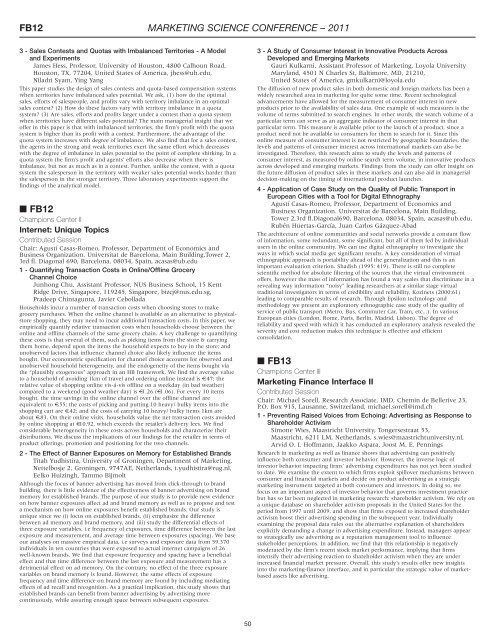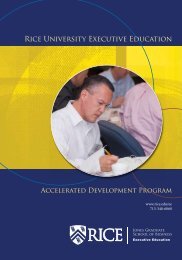Conference Sessions - Jesse H. Jones Graduate School of ...
Conference Sessions - Jesse H. Jones Graduate School of ...
Conference Sessions - Jesse H. Jones Graduate School of ...
You also want an ePaper? Increase the reach of your titles
YUMPU automatically turns print PDFs into web optimized ePapers that Google loves.
FB12 MARKETING SCIENCE CONFERENCE – 2011<br />
3 - Sales Contests and Quotas with Imbalanced Territories - A Model<br />
and Experiments<br />
James Hess, Pr<strong>of</strong>essor, University <strong>of</strong> Houston, 4800 Calhoun Road,<br />
Houston, TX, 77204, United States <strong>of</strong> America, jhess@uh.edu,<br />
Niladri Syam, Ying Yang<br />
This paper studies the design <strong>of</strong> sales contests and quota-based compensation systems<br />
when territories have imbalanced sales potential. We ask, (1) how do the optimal<br />
sales, efforts <strong>of</strong> salespeople, and pr<strong>of</strong>its vary with territory imbalance in an optimal<br />
sales contest? (2) How do these factors vary with territory imbalance in a quota<br />
system? (3) Are sales, efforts and pr<strong>of</strong>its larger under a contest than a quota system<br />
when territories have different sales potential? The main managerial insight that we<br />
<strong>of</strong>fer in this paper is that with imbalanced territories, the firm’s pr<strong>of</strong>it with the quota<br />
system is higher than its pr<strong>of</strong>it with a contest. Furthermore, the advantage <strong>of</strong> the<br />
quota system increases with degree <strong>of</strong> imbalance. We also find that for a sales contest,<br />
the agents in the strong and weak territories exert the same effort which decreases<br />
with the degree <strong>of</strong> imbalance in sales potential to the point <strong>of</strong> complete shirking. In a<br />
quota system the firm’s pr<strong>of</strong>it and agents’ efforts also decrease when there is<br />
imbalance, but not as much as in a contest. Further, unlike the contest, with a quota<br />
system the salesperson in the territory with weaker sales potential works harder than<br />
the salesperson in the stronger territory. Three laboratory experiments support the<br />
findings <strong>of</strong> the analytical model.<br />
■ FB12<br />
Champions Center II<br />
Internet: Unique Topics<br />
Contributed Session<br />
Chair: Agustí Casas-Romeo, Pr<strong>of</strong>essor, Department <strong>of</strong> Economics and<br />
Business Organization. Universitat de Barcelona, Main Building,Tower 2,<br />
3rd fl. Diagonal 690, Barcelona, 08034, Spain, acasas@ub.edu<br />
1 - Quantifying Transaction Costs in Online/Offline Grocery<br />
Channel Choice<br />
Junhong Chu, Assistant Pr<strong>of</strong>essor, NUS Business <strong>School</strong>, 15 Kent<br />
Ridge Drive, Singapore, 119245, Singapore, bizcj@nus.edu.sg,<br />
Pradeep Chintagunta, Javier Cebollada<br />
Households incur a number <strong>of</strong> transaction costs when choosing stores to make<br />
grocery purchases. When the online channel is available as an alternative to physicalstore<br />
shopping, they may need to incur additional transaction costs. In this paper, we<br />
empirically quantify relative transaction costs when households choose between the<br />
online and <strong>of</strong>fline channels <strong>of</strong> the same grocery chain. A key challenge to quantifying<br />
these costs is that several <strong>of</strong> them, such as picking items from the store & carrying<br />
them home, depend upon the items the household expects to buy in the store; and<br />
unobserved factors that influence channel choice also likely influence the items<br />
bought. Our econometric specification for channel choice accounts for observed and<br />
unobserved household heterogeneity, and the endogeneity <strong>of</strong> the items bought via<br />
the “plausibly exogenous” approach in an HB framework. We find the average value<br />
to a household <strong>of</strong> avoiding 1km <strong>of</strong> travel and ordering online instead is €.47; the<br />
relative value <strong>of</strong> shopping online vis-á-vis <strong>of</strong>fline on a weekday (in bad weather)<br />
compared to a weekend (good weather day) is €1.26 (€1.06). For every 10 items<br />
bought, the time savings in the online channel over the <strong>of</strong>fline channel are<br />
equivalent to €.55; the costs <strong>of</strong> picking and putting 10 heavy/ bulky items into the<br />
shopping cart are €.42; and the costs <strong>of</strong> carrying 10 heavy/ bulky items 1km are<br />
about €.83. On their online visits, households value the net transaction costs avoided<br />
by online shopping at €10.92, which exceeds the retailer’s delivery fees. We find<br />
considerable heterogeneity in these costs across households and characterize their<br />
distributions. We discuss the implications <strong>of</strong> our findings for the retailer in terms <strong>of</strong><br />
product <strong>of</strong>ferings, promotion and positioning for the two channels.<br />
2 - The Effect <strong>of</strong> Banner Exposures on Memory for Established Brands<br />
Titah Yudhistira, University <strong>of</strong> Groningen, Department <strong>of</strong> Marketing,<br />
Nettelbosje 2, Groningen, 9747AE, Netherlands, t.yudhistira@rug.nl,<br />
Eelko Huizingh, Tammo Bijmolt<br />
Although the focus <strong>of</strong> banner advertising has moved from click-through to brand<br />
building, there is little evidence <strong>of</strong> the effectiveness <strong>of</strong> banner advertising on brand<br />
memory for established brands. The purpose <strong>of</strong> our study is to provide new evidence<br />
on how banner exposures affect ad and brand memory as well as to propose and test<br />
a mechanism on how online exposures benefit established brands. Our study is<br />
unique since we (i) focus on established brands, (ii) emphasize the difference<br />
between ad memory and brand memory, and (iii) study the differential effects <strong>of</strong><br />
three exposure variables, i.e frequency <strong>of</strong> exposures, time difference between the last<br />
exposure and measurement, and average time between exposures (spacing). We base<br />
our analyses on massive empirical data, i.e surveys and exposure data from 59.370<br />
individuals in ten countries that were exposed to actual internet campaigns <strong>of</strong> 26<br />
well-known brands. We find that exposure frequency and spacing have a beneficial<br />
effect and that time difference between the last exposure and measurement has a<br />
detrimental effect on ad memory. On the contrary, no effect <strong>of</strong> the three exposure<br />
variables on brand memory is found. However, the same effects <strong>of</strong> exposure<br />
frequency and time difference on brand memory are found by including mediating<br />
effects <strong>of</strong> ad recall and recognition. As a practical implication, this study shows that<br />
established brands can benefit from banner advertising by advertising more<br />
continuously, while assuring enough space between subsequent exposures.<br />
50<br />
3 - A Study <strong>of</strong> Consumer Interest in Innovative Products Across<br />
Developed and Emerging Markets<br />
Gauri Kulkarni, Assistant Pr<strong>of</strong>essor <strong>of</strong> Marketing, Loyola University<br />
Maryland, 4501 N Charles St, Baltimore, MD, 21210,<br />
United States <strong>of</strong> America, gmkulkarni@loyola.edu<br />
The diffusion <strong>of</strong> new product sales in both domestic and foreign markets has been a<br />
widely researched area in marketing for quite some time. Recent technological<br />
advancements have allowed for the measurement <strong>of</strong> consumer interest in new<br />
products prior to the availability <strong>of</strong> sales data. One example <strong>of</strong> such measures is the<br />
volume <strong>of</strong> terms submitted to search engines. In other words, the search volume <strong>of</strong> a<br />
particular term can serve as an aggregate indicator <strong>of</strong> consumer interest in that<br />
particular term. This measure is available prior to the launch <strong>of</strong> a product, since a<br />
product need not be available to consumers for them to search for it. Since this<br />
online measure <strong>of</strong> consumer interest is not restricted by geographic boundaries, the<br />
levels and patterns <strong>of</strong> consumer interest across international markets can also be<br />
investigated. Therefore, this research aims to study the levels and patterns <strong>of</strong><br />
consumer interest, as measured by online search term volume, in innovative products<br />
across developed and emerging markets. Findings from the study can <strong>of</strong>fer insight on<br />
the future diffusion <strong>of</strong> product sales in these markets and can also aid in managerial<br />
decision-making on the timing <strong>of</strong> international product launches.<br />
4 - Application <strong>of</strong> Case Study on the Quality <strong>of</strong> Public Transport in<br />
European Cities with a Tool for Digital Ethnography<br />
Agustí Casas-Romeo, Pr<strong>of</strong>essor, Department <strong>of</strong> Economics and<br />
Business Organization. Universitat de Barcelona, Main Building,<br />
Tower 2,3rd fl.Diagonal690, Barcelona, 08034, Spain, acasas@ub.edu,<br />
Rubén Huertas-García, Juan Carlos Gázquez-Abad<br />
The architecture <strong>of</strong> online communities and social networks provide a constant flow<br />
<strong>of</strong> information, some redundant, some significant, but all <strong>of</strong> them fed by individual<br />
users in the online community. We can use digital ethnography to investigate the<br />
ways in which social media get significant results. A key consideration <strong>of</strong> virtual<br />
ethnographic approach is portability ahead <strong>of</strong> the generalization and this is an<br />
important evaluation criterion. Shadish (1995: 419). There is still no complete<br />
scientific method for absolute filtering <strong>of</strong> the sources that the virtual environment<br />
<strong>of</strong>fers, however the mass <strong>of</strong> information has found a way scales that discriminate in a<br />
revealing way information “noisy” leading researchers at a similar stage virtual<br />
traditional investigators in terms <strong>of</strong> credibility and reliability, Kozinets (2000:61)<br />
leading to comparable results <strong>of</strong> research. Through Epsilon technology and<br />
methodology we present an exploratory ethnographic case study <strong>of</strong> the quality <strong>of</strong><br />
service <strong>of</strong> public transport (Metro, Bus, Commuter Car, Tram, etc...). In various<br />
European cities (London, Rome, Paris, Berlin, Madrid, Lisbon). The degree <strong>of</strong><br />
reliability and speed with which it has conducted an exploratory analysis revealed the<br />
severity and cost reduction makes this technique is effective and efficient<br />
consolidation.<br />
■ FB13<br />
Champions Center III<br />
Marketing Finance Interface II<br />
Contributed Session<br />
Chair: Michael Sorell, Research Associate, IMD, Chemin de Bellerive 23,<br />
P.O. Box 915, Lausanne, Switzerland, michael.sorell@imd.ch<br />
1 - Preventing Raised Voices from Echoing: Advertising as Response to<br />
Shareholder Activism<br />
Simone Wies, Maastricht University, Tongersestraat 53,<br />
Maastricht, 6211 LM, Netherlands, s.wies@maastrichtuniversity.nl,<br />
Arvid O. I. H<strong>of</strong>fmann, Jaakko Aspara, Joost M. E. Pennings<br />
Research in marketing as well as finance shows that advertising can positively<br />
influence both consumer and investor behavior. However, the inverse logic <strong>of</strong><br />
investor behavior impacting firms’ advertising expenditures has not yet been studied<br />
to date. We examine the extent to which firms exploit spillover mechanisms between<br />
consumer and financial markets and decide on product advertising as a strategic<br />
marketing instrument targeted at both consumers and investors. In doing so, we<br />
focus on an important aspect <strong>of</strong> investor behavior that governs investment practice<br />
but has so far been neglected in marketing research: shareholder activism. We rely on<br />
a unique database on shareholder activism proposals in the United States for the<br />
period from 1997 until 2009, and show that firms exposed to increased shareholder<br />
activism boost their advertising spending in the subsequent year. Individually<br />
examining the proposal data rules out the alternative explanation <strong>of</strong> shareholders<br />
explicitly demanding a change in advertising expenditure. Instead, managers appear<br />
to strategically use advertising as a reputation management tool to influence<br />
stakeholder perceptions. In addition, we find that this relationship is negatively<br />
moderated by the firm’s recent stock market performance, implying that firms<br />
intensify their advertising reaction to shareholder activism when they are under<br />
increased financial market pressure. Overall, this study’s results <strong>of</strong>fer new insights<br />
into the marketing-finance interface, and in particular the strategic value <strong>of</strong> marketbased<br />
assets like advertising.

















